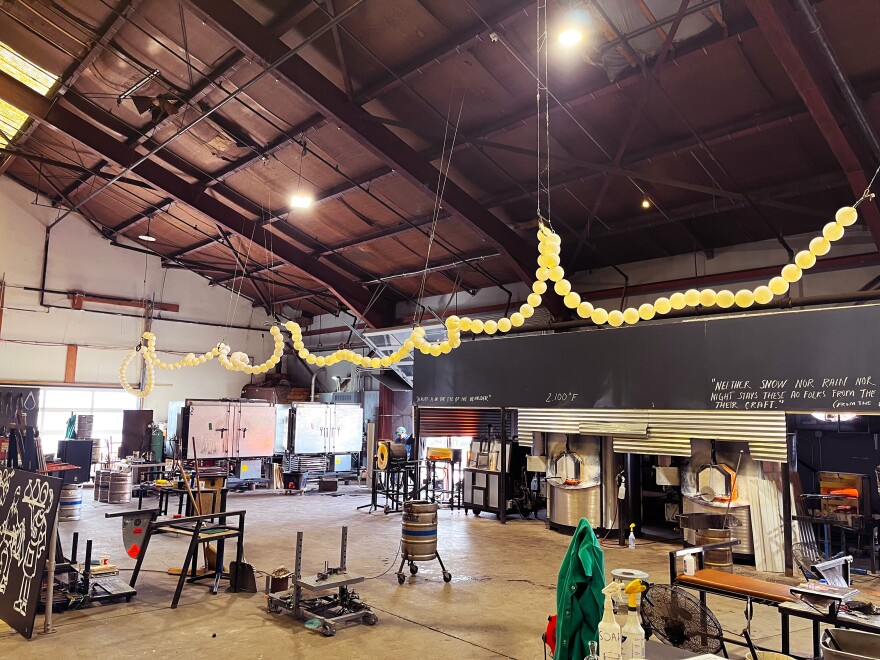Vermont Public reporters are exploring the many meanings of the word "heat." As part of this series, editor Brittany Patterson visited the hot shop at AO Glass in Burlington. Here's co-owner Rich Arentzen in his own words:
(Note: this story was produced for the ear. We recommend listening, if you are able.)
My name is Rich Arentzen. I run, with my wife Tove Ohlander, AO Glass in Burlington, Vermont.
This is called the hot shop of AO Glass. It's behind Arts Riot and Speeder and Earl's on Pine Street in Burlington.
More from Vermont Public: What 'heat' means to a Vermont pig farmer
We have four furnaces and four reheating chambers. On any given day, there may be eight professional glass blowers and assistants.
Ninety-five percent of what we do is making custom lampshades for larger companies. We make drinking glasses; we make ornaments; we make sculptural bags; we make pumpkins; we've made lots of polar bears, and snowmen, and we made Champ. We make all sorts of stuff.

First, we buy raw material from Sweden that comes in batch pelletized form.
Glass is probably 70-80% silica, but you have to combine it with things to lower the melting point of that silica.
And then we have to melt it, which means throwing it into our furnaces, which hold roughly 1,000 pounds of glass each, and cook it at a temperature of around 2,350 degrees Fahrenheit.
"We're really just taking sand, imagination and some sweat and turning it into something that looks beautiful, and that's a spectacular thing to be involved with."Rich Arentzen, co-founder of AO Glass
So the glass cooks overnight, the bubbles kind of froth up a little like you're opening a bottle of seltzer. Within a day or two, you have ideally bubble-free glass.
When we take the glass out of the furnace, it's kept it around 2,100 degrees. We'll stick a metal rod into it and turn it a little like you can turn a straw in honey and gather a gob of glass — which is the official term — onto the end of what's called a blowing pipe. It's a hollow tube.
And using newspaper or wooden tools, we're able to keep it round. Some of the other [ways include] using gravity, centripetal force — we are able to coax it into the final shape.

With the lighting components, especially, we'll use molds, because the exterior diameter is essential to fit whatever lighting product we're working on.
And so at that point, you're able to take the glass and flip it from the glassblowing iron onto a solid rod with a little bit of glass on it. It's like high-temperature juggling. And then there's a little hole on the top, and you're able to heat that up, and by spinning in and using a specialized metal tool, turn it into a finished glass.
After that, the glass always has to anneal, which is kept in our cooling oven, which is a cooling oven of 900 degrees Fahrenheit. And then from that point it cools slowly overnight to relieve any internal stress.

What's really exciting with glassblowing, let's just say you make something, you can't touch it or see it really until the next day. So you kind of run to the studio the next morning and open the annealer, and hope that what you see is as beautiful as what you can imagine in your head. And sometimes it isn't, sometimes it's not, but it's always a nice surprise.
More from Vermont Public: Craving some warmth? Try a 180-degree backyard sauna
After the recession, people became much more conscious of trying to buy American-made products, whenever possible. So that gave us an opening. As that business started to grow, it enabled us to move from our 400-square-foot studio office warehouse into a 10,000-square-foot facility that we have now, where we employ 30 people making glass.

We have people checking the glass, going through a QC process, and packing and in the background, we have people cold working. We have four cold workers, and they are grinding and polishing.
One of the things I like about having visitors come in is you really get to appreciate the magic of what's really going on. For me most of the time, it's the struggle of trying to make what's in my head or thinking about the business, but when we have visitors, you can really say wow, this is an incredible thing that we're doing.
We're really just taking sand, imagination and some sweat and turning it into something that looks beautiful, and that's a spectacular thing to be involved with.
This story was reported and produced by Brittany Patterson.
Have questions, comments or tips? Send me an email at brittany.patterson@vermontpublic.org.





